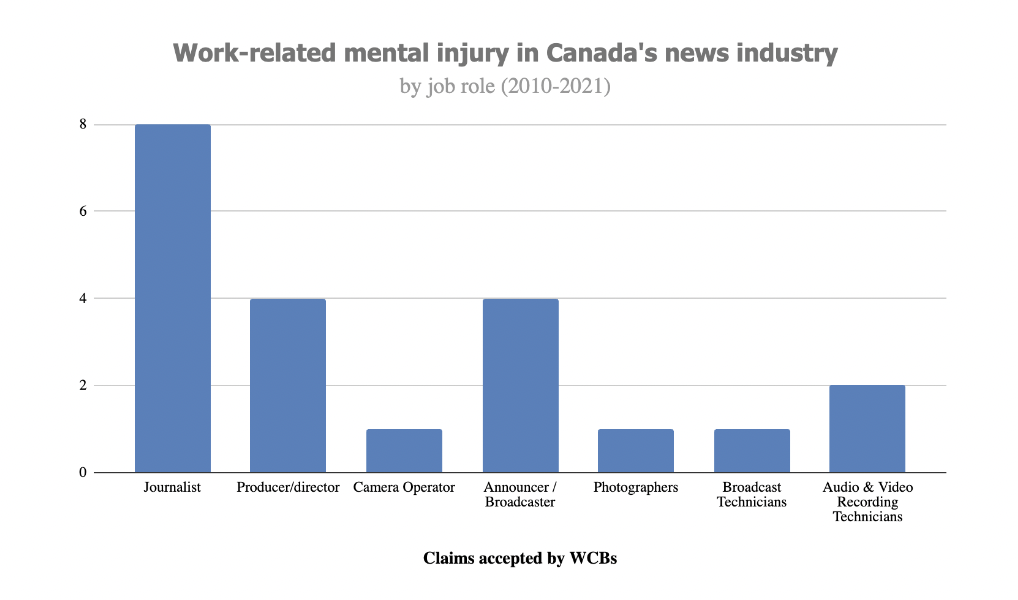Journalists ‘psychologically injured’ at work on the rise in Canada
Two dozen cases of PTSD, stress, anxiety officially recognized by worker compensation boards since 2010
Announcers, camera operators, producers, photographers among those mentally injured on the job. (Getty Images)
OPINION
I found out recently a journalist friend in Nova Scotia is off work, recovering from an official diagnosis this spring of PTSD resulting from her job.
It's devastating given her stellar work and dedication, including covering a deadly 2020 cross-province mass shooting incident and the long public inquiry that followed.
Nova Scotia’s Workers’ Compensation Board ruled in May that cumulative exposure on the job to the details of the shooting rampage — the horror, the stories of the grieving — has deeply injured her.
In my work as a journalist and mental health educator, I’ve written about two other known cases of journalist PTSD formally recognized in Ontario.
Ontario’s Workplace Safety & Insurance Board ruled in late 2022 that video journalist Colin Butler’s PTSD was due to repeatedly witnessing trauma on the job. (supplied)
It’s important we learn about these cases as our understanding evolves around vicarious trauma and its impact on professions like police officers, paramedics, court staff — and news crews.
It’s vital we uncover just how frequently our people are mentally injured from our work — for our own awareness, but also to ensure our news companies pay attention, examine the risks, and take appropriate action to better protect people who routinely cover trauma and human suffering.
So I asked workers’ compensation agencies in every province and territory: “How many news professionals have had claims of psychological injury from their jobs accepted in the last few years?”
The data came back spotty, shrouded in secrecy out of concern for people’s privacy.
The best numbers I could gather come from the Association of Workers’ Compensation Boards of Canada (AWCBC) which dug up data from 2010-2021.
In all, they recorded 21 cases where formal claims were officially accepted. Plus, I know of two other cases more recent than 2021 – the case of Colin Butler in Ontario, and now my colleague in Nova Scotia. There may be others.
Here’s what these data show about news professionals:
PTSD and other trauma-related disorders make up two thirds of accepted mental injury claims
Numbers of trauma, stress, anxiety injuries among news people are on the rise
BC and Quebec accepted the most claims
Cases rise after 2013 when secondary trauma for frontline professionals was added to the Diagnostic Statistical Manual (DSM) by the American Psychiatric Association.
Of course, these numbers of accepted claims reflect only a tiny fraction of all psychological stress injuries or illnesses suffered by news professionals.
Most would never file a compensation claim so wouldn’t be counted. Most freelancers aren’t even covered by workplace insurance.
We know from Taking Care: a report on mental health, well-being and trauma among Canadian news workers based on a survey of 1251 repondents that more than half (54%) have sought medical advice or treatment for work related stress and trauma.
It’s not just frontline journalists affected but also video editors, technicians, media librarians and office workers who spend a lot of time viewing graphic imagery or consuming disturbing details.
The AWCBC data reflect this too.
Quebec and British Columbia reported the most accepted claims.
A WorkSafeBC spokesperson says the province rewrote its policy around workplace mental health injuries in 2012, which now accepts claims for cumulative trauma exposure for professionals who routinely witness aversive details and images. This includes journalists.
Nova Scotia’s Workers’ Compensation Board (NSWCB) says overall numbers of claims for workplace psychological injuries are on the rise.
“It's certainly true that traumatic events affect not only first responders but many others as well, including journalists and other occupations,” NSWCB spokesperson Heather MacLeod wrote in an email.
“Because we are seeing an increase in psychological injuries in the workplace, we introduced a Traumatic Psychological Injury (TPI) Program in 2021, to provide workers and employers with an accessible approach to supporting workers… This dedicated service model is showing progress, as we work to assist individuals recovering from these challenging, complex injuries.”
As news companies look for strategies and new practices to better support staff who cover the ‘tough stuff,’ here are some leading strategies from a previous blog entry to help make newsrooms and journalism safer and psychologicially healthier.
Because, based on these injury numbers, our industry and our people clearly need it.







